I believe I invented a new kind of speaker enclosure.
This is an "Open Baffle Reflex Hybrid" which has the upper half of the woofer exposed on the rear of the cabinet (dipole), with the lower half of the woofer reflex loaded.


A special divider (see center photo of the oddly shaped piece of wood) wedges across the middle of the woofer, creating separation between the open baffle top and the bass reflex bottom. This structure comes to within 1cm of the cone (left picture). Right photo shows the speaker before I installed the divider. The opening just behind the cone doubles as the bass port. There is no other port.
The closer I was able to get the divider to the woofer cone, the lower I could tune the port. A larger gap would tune the system to a higher frequency. A smaller gap would tune lower, but invite the cone slapping against the divider.
Below is the frequency & phase response in-room of the finished system:

This divider is air-sealed against the magnet and spokes of the frame with modeling clay. The tuning frequency is 57Hz which was the lowest I could attain, given the size of the enclosure (~1ft^3 / 28 liters) while not making the space between the divider and the woofer cone prohibitively narrow.
The impedance curve shows the reflex tuning:

About 1/3 of the back of the woofer is exposed and 2/3 funnels down into the enclosure. The polar pattern is really more like a cardioid. (However, I'm sorry I only have 180 degree polar plots, not 360.)

The polar spectrum shows a very even constant directivity of about 90 degrees from 100Hz to 20KHz. The tweeter is the classic Audax TW034X0 ("D34") mated to a 6.5" Troels Graveson waveguide, which makes a superb combination.
This is frequency response about 2 feet in front of the speaker. This position doesn't pick up the rear port radiation which is why you see the response droop below 150Hz. The farfield is better as you can see in a different curve above. This shows 1/3 octave plots at 0, 15, 30, 45, 60, 75, and 90 degrees. As you can see it achieves constant directivity from the bass midrange to the treble.

Below 100Hz the speaker becomes roughly omnidirectional with the majority of the output coming from the port. The port has a pretty decent bass peak at about 65Hz with useful output down to just below 50Hz. One drawback is that at high levels there's a fair amount of port chuffing. It's unavoidable given the narrowness of the port necessary to tune the box down to 55Hz.
A problem with this design for high excursions is that as the woofer moves, it is also changing the tuning frequency at the same rate as the signal is varying; so that creates some cringy distortion at high levels. Also it's likely I am getting cone rocking at high levels because of the asymmetry of the air loading. But it's less distortion than the same woofer in a dipole at the same volume level :^>
The Dayton RS270P is an excellent driver. It’s used in some pretty expensive commercial designs. It’s good looking, has very smooth response, has a hard pressed paper cone which makes a very incisive crisp character.

I used DSP to straighten out the anomalies, of which there are several. ABOVE, see graphic of the DSP bass EQ correction curve, labeled according to which problem is being fixed. It would be pretty hard but not necessarily impossible to execute these with a passive crossover. It would take a lot of trial and error. Not pictured is 3rd order 1500Hz xover between woofer and tweeter. The MiniDSP introduces a sharp high-pass filter below 50Hz which protects the woofer from too much excursion. Very important.
I used FIR DSP all pass filters to correct the phase response so the system is linear phase from 100Hz to 20KHz with outstanding impulse and step response.

I could perhaps have patented this unusual enclosure design. But I don’t care to be in the speaker business, and as a business consultant I think most patents are overrated anyway. So I’m giving the design away here.
They are biamped. You can download MiniDSP file here.
This is the cabinet sketch I gave to my Chicago-based carpenter, Seth Cothron, @studio38designs.
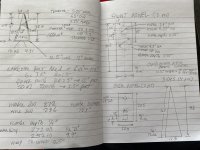
They sound fantastic. The stereo image is wide and full; they have more bass than a 10” in a straight dipole would produce, and they produce the warm ambient sound you expect from an Open Baffle design. You can't push them terribly hard in the bass (more of a jazz speaker than a rock speaker) but they certainly play a lot louder than if they were normal dipoles; they can play roughly as loud as if this same 10” woofer was in a sealed box.
The imaging is superb everywhere in the room, even standing right next to one speaker; and they are very transparent with great clarity.
On the back panel is also a Peerless 1" dome tweeter BC25SC06-04 for back fill - I find dipoles sound much better with full spectrum on both sides.
Below is the tweeter schematic. The tweeters are wired in series and the LC circuit reduces the sensitivity of the rear tweeter while making the front and rear tweeter curves match better. Woofers are wired straight to the LF amp.
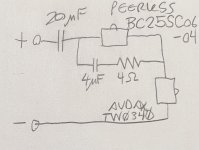
I built these two years ago, and a friend suggested that maybe it would be easier to just build a dipole with two separate woofers, instead of creating all of the baffling necessary to divide the output of one. So I did, and the result was the Flanagangsters which I posted about 2 months ago.
I really enjoyed trying something unconventional and I encourage y’all to generate variations of this new enclosure type.
Perry Marshall

This is an "Open Baffle Reflex Hybrid" which has the upper half of the woofer exposed on the rear of the cabinet (dipole), with the lower half of the woofer reflex loaded.
A special divider (see center photo of the oddly shaped piece of wood) wedges across the middle of the woofer, creating separation between the open baffle top and the bass reflex bottom. This structure comes to within 1cm of the cone (left picture). Right photo shows the speaker before I installed the divider. The opening just behind the cone doubles as the bass port. There is no other port.
The closer I was able to get the divider to the woofer cone, the lower I could tune the port. A larger gap would tune the system to a higher frequency. A smaller gap would tune lower, but invite the cone slapping against the divider.
Below is the frequency & phase response in-room of the finished system:
This divider is air-sealed against the magnet and spokes of the frame with modeling clay. The tuning frequency is 57Hz which was the lowest I could attain, given the size of the enclosure (~1ft^3 / 28 liters) while not making the space between the divider and the woofer cone prohibitively narrow.
The impedance curve shows the reflex tuning:
About 1/3 of the back of the woofer is exposed and 2/3 funnels down into the enclosure. The polar pattern is really more like a cardioid. (However, I'm sorry I only have 180 degree polar plots, not 360.)
The polar spectrum shows a very even constant directivity of about 90 degrees from 100Hz to 20KHz. The tweeter is the classic Audax TW034X0 ("D34") mated to a 6.5" Troels Graveson waveguide, which makes a superb combination.
This is frequency response about 2 feet in front of the speaker. This position doesn't pick up the rear port radiation which is why you see the response droop below 150Hz. The farfield is better as you can see in a different curve above. This shows 1/3 octave plots at 0, 15, 30, 45, 60, 75, and 90 degrees. As you can see it achieves constant directivity from the bass midrange to the treble.
Below 100Hz the speaker becomes roughly omnidirectional with the majority of the output coming from the port. The port has a pretty decent bass peak at about 65Hz with useful output down to just below 50Hz. One drawback is that at high levels there's a fair amount of port chuffing. It's unavoidable given the narrowness of the port necessary to tune the box down to 55Hz.
A problem with this design for high excursions is that as the woofer moves, it is also changing the tuning frequency at the same rate as the signal is varying; so that creates some cringy distortion at high levels. Also it's likely I am getting cone rocking at high levels because of the asymmetry of the air loading. But it's less distortion than the same woofer in a dipole at the same volume level :^>
The Dayton RS270P is an excellent driver. It’s used in some pretty expensive commercial designs. It’s good looking, has very smooth response, has a hard pressed paper cone which makes a very incisive crisp character.

I used DSP to straighten out the anomalies, of which there are several. ABOVE, see graphic of the DSP bass EQ correction curve, labeled according to which problem is being fixed. It would be pretty hard but not necessarily impossible to execute these with a passive crossover. It would take a lot of trial and error. Not pictured is 3rd order 1500Hz xover between woofer and tweeter. The MiniDSP introduces a sharp high-pass filter below 50Hz which protects the woofer from too much excursion. Very important.
I used FIR DSP all pass filters to correct the phase response so the system is linear phase from 100Hz to 20KHz with outstanding impulse and step response.
I could perhaps have patented this unusual enclosure design. But I don’t care to be in the speaker business, and as a business consultant I think most patents are overrated anyway. So I’m giving the design away here.
They are biamped. You can download MiniDSP file here.
This is the cabinet sketch I gave to my Chicago-based carpenter, Seth Cothron, @studio38designs.

They sound fantastic. The stereo image is wide and full; they have more bass than a 10” in a straight dipole would produce, and they produce the warm ambient sound you expect from an Open Baffle design. You can't push them terribly hard in the bass (more of a jazz speaker than a rock speaker) but they certainly play a lot louder than if they were normal dipoles; they can play roughly as loud as if this same 10” woofer was in a sealed box.
The imaging is superb everywhere in the room, even standing right next to one speaker; and they are very transparent with great clarity.
On the back panel is also a Peerless 1" dome tweeter BC25SC06-04 for back fill - I find dipoles sound much better with full spectrum on both sides.
Below is the tweeter schematic. The tweeters are wired in series and the LC circuit reduces the sensitivity of the rear tweeter while making the front and rear tweeter curves match better. Woofers are wired straight to the LF amp.

I built these two years ago, and a friend suggested that maybe it would be easier to just build a dipole with two separate woofers, instead of creating all of the baffling necessary to divide the output of one. So I did, and the result was the Flanagangsters which I posted about 2 months ago.
I really enjoyed trying something unconventional and I encourage y’all to generate variations of this new enclosure type.
Perry Marshall
Attachments
-
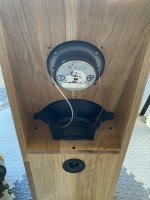 +hybrid_open_back_reflex__2945.JPG482.3 KB · Views: 379
+hybrid_open_back_reflex__2945.JPG482.3 KB · Views: 379 -
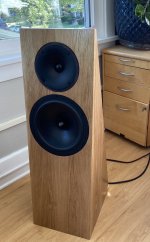 +hybrid_open_back_reflex__29572.JPG376.2 KB · Views: 642
+hybrid_open_back_reflex__29572.JPG376.2 KB · Views: 642 -
 +hybrid_open_back_reflex__2944.JPG566.5 KB · Views: 413
+hybrid_open_back_reflex__2944.JPG566.5 KB · Views: 413 -
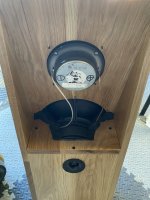 +hybrid_open_back_reflex__2945.JPG482.3 KB · Views: 363
+hybrid_open_back_reflex__2945.JPG482.3 KB · Views: 363 -
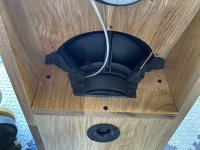 +hybrid_open_back_reflex__2946.JPG495.7 KB · Views: 345
+hybrid_open_back_reflex__2946.JPG495.7 KB · Views: 345 -
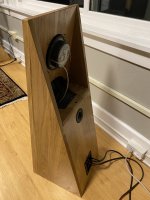 +hybrid_open_back_reflex__2953.JPG461.2 KB · Views: 949
+hybrid_open_back_reflex__2953.JPG461.2 KB · Views: 949
Last edited by a moderator:
Thanks for sharing, very interesting reading.
May I suggest you to try with more thick divider, say double or triple thickness.
It will make the "port" longer so you can get the same (or even lower) tuning with more clearance from the cone, reducing the negative effects you described.
May I suggest you to try with more thick divider, say double or triple thickness.
It will make the "port" longer so you can get the same (or even lower) tuning with more clearance from the cone, reducing the negative effects you described.
Interesting. It looks to be a similar concept to Steve Deckert's ZOB project, albeit with a dedicated LF unit and much tighter direct-coupling to the Helmholtz resonator than the indirect type Steve tried. Great creativity & many thanks for sharing! 🙂
I was thinking the same thing. I built the ZOBs some years back as my first OB try, and was really disappointed in the bass response. They didn’t stick around long. Looks like these may improve on that.It looks to be a similar concept to Steve Deckert's ZOB project
Awed speechless. Maybe, strips of very thin foam-seal or automotive-plast-tape, metal-foil sandwich, attached to the cone so as to bridge-over the "gap" without hitting, thus reducing and making constant the gap leak. Just a thought!
p.s. horseshoe-dam curved strips for strength
p.s. horseshoe-dam curved strips for strength
Last edited:
Yes, and in fact on an 8-spoke woofer basket, the best approach may be blocking the entire space between spokes on left and right edges, so that the upper 3/8 is exposed and the lower 3/8 is inside the reflex box.Thanks for sharing, very interesting reading.
May I suggest you to try with more thick divider, say double or triple thickness.
It will make the "port" longer so you can get the same (or even lower) tuning with more clearance from the cone, reducing the negative effects you described.
I would enjoy trying this on a 15” coax.
Tech note: you do all the normal reflex calculations but then divide the box volume in half. You think of the reflex side of the driver as a woofer with half the Sd.
Was not aware. Looked it up. Yes, definitely some similarities.Interesting. It looks to be a similar concept to Steve Deckert's ZOB project, albeit with a dedicated LF unit and much tighter direct-coupling to the Helmholtz resonator than the indirect type Steve tried. Great creativity & many thanks for sharing! 🙂
I believe I invented a new kind of speaker enclosure.
We built something very similar in the mid 2000s. A prototype for Tekton. Signed an NDA so can’t say much. It didn’t work all that well but that could have been driver choice. Althou i guess sinse Steve Deckert's ZOB project was a copy of that work by Alexander.
Under dynamic conditions the vent tuning is going to be constantly changing with the music. That can’t be good.
dave
@planet10 yes you're right and it also mirrors the problem of a pro coaxial where the woofer cone is an extension of the tweeter horn. If the cone is moving very far, the horn is changing shape and you get modulation.
So you are correct - this design is definitely not without its problems. I wouldn't say I'm unconditionally enthusiastic about it. It's Bill Duddleston's aphorism "If you can see the cone moving, it's distorting" squared.
That said... it does kill several birds with one stone. If you used a Reflex-Dipole Hybrid enclosure with a 15" coax like the B&C 15CXN88 then you have a lot of surface area and the ability to go down to 40-50Hz, and play pretty loud, with not much excursion. As long as cone excursion is under 2mm or so, you're good across the board.
So you are correct - this design is definitely not without its problems. I wouldn't say I'm unconditionally enthusiastic about it. It's Bill Duddleston's aphorism "If you can see the cone moving, it's distorting" squared.
That said... it does kill several birds with one stone. If you used a Reflex-Dipole Hybrid enclosure with a 15" coax like the B&C 15CXN88 then you have a lot of surface area and the ability to go down to 40-50Hz, and play pretty loud, with not much excursion. As long as cone excursion is under 2mm or so, you're good across the board.
I see this a lot, but how is this different from any driver covering several octaves? We usually assume that the cone is performing within its pistonic motion band and no deformation of the cone is taking place, right?yes you're right and it also mirrors the problem of a pro coaxial where the woofer cone is an extension of the tweeter horn. If the cone is moving very far, the horn is changing shape and you get modulation.
Planet10 is saying that, in addition to the usual problems with high excursion, it also means the port diameter is effectively changing as well. So it does compound the problem.I see this a lot, but how is this different from any driver covering several octaves? We usually assume that the cone is performing within its pistonic motion band and no deformation of the cone is taking place, right?
Another issue to be aware of is the dynamic load on the cone at various frequencies and it differing across the cone surface. The uneven load in some circumstances will cause cone rocking and VC rubbing as a consequence.
I built a sub many years back using this design of yours and it had issues with VC rubbing at higher levels. I revised the design to use two symmetrical chanbers 180 degrees apart to solve to problem, but it didn't perform as well as the single sided chamber.
I built a sub many years back using this design of yours and it had issues with VC rubbing at higher levels. I revised the design to use two symmetrical chanbers 180 degrees apart to solve to problem, but it didn't perform as well as the single sided chamber.
I agree with Dave that it's a problematic design, and I see no upside for it.
So don't do that. Cross to a dedicated LF driver to minimise the coax cone movement, something I started doing at least 25 ya.yes you're right and it also mirrors the problem of a pro coaxial where the woofer cone is an extension of the tweeter horn. If the cone is moving very far, the horn is changing shape and you get modulation.
@Brett I did a 2-woofer version of this at https://www.diyaudio.com/community/threads/open-baffle-bass-reflex-hybrid.393837/
Of course I prefer 2 drivers as well, but that is not always feasible.
Of course I prefer 2 drivers as well, but that is not always feasible.
Looking at what you're trying to do, I don't see why not.Of course I prefer 2 drivers as well, but that is not always feasible.
Coax cone movement is pretty much a non issue in a 10-12” pro driver ime.
The thing to worry about in a coax is tha the ideal shape of the cone is not the same for waveguide behaviour as for break up. This makes for pretty challenging crossover designs.
This is a 10” coax over a 12” bass, allowing the coax to go as deep as possible to maintain the point source characteristics down to the Schröder freq is much more critical for sq.

The thing to worry about in a coax is tha the ideal shape of the cone is not the same for waveguide behaviour as for break up. This makes for pretty challenging crossover designs.
This is a 10” coax over a 12” bass, allowing the coax to go as deep as possible to maintain the point source characteristics down to the Schröder freq is much more critical for sq.
Last edited:
It’s a non-issue if the coax is not expected to deliver a lot of bass. It’s a serious issue if it’s a full range dipole with no subwoofer.
First thought was its kind of a "half-coupled" R-J of yore. I say have fun and chase every trail as long as it stays fun. Thanks for posting.
True dat, but I think you'd be hard pressed to find such a beast of a transducer; then again I can't really think of a reason why you'd want to go that way.It’s a non-issue if the coax is not expected to deliver a lot of bass. It’s a serious issue if it’s a full range dipole with no subwoofer.
Never really been in the OB camp myself so I'm really the wrong guy to have an opinion anyway😉 Only OB system I heard with any kind of impact in the mid-bass had 10 of these
Maybe something like this could work:
https://www.bmsspeakers.com/fileadm...n682_2011-04_neodymium_coaxial_transducer.pdf
Last edited by a moderator:
- Home
- Loudspeakers
- Multi-Way
- NEW Speaker Enclosure Type: Open Back-Reflex Hybrid w/ Single Woofer